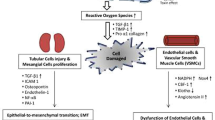Abstract
“Uraemia” literally means “urine in blood”. With the advancement of basic medical sciences, it is being better understood. The clinical syndrome of uraemia is due to the failure of not only the excretory but also the metabolic, regulatory and endocrine functions of the kidney. Apart from the “retained toxic metabolites”, a number of guanidine derivatives had been found which are now considered to be more important in the causation of the uraemic syndrome. Cohen had hypothesised that nitrogen retention in uraemia causes an aberration in the urea cycle that in turn leads to the production of guanidinosuccinic acid (GSA) in large amounts. However, it appears that methylguanidine (MG) is produced from the degradation of creatinine by the gut flora in uraemics. Both GSA and MG are proved to be toxic. The role of GSA in uraemic neurotoxicity and coma is still controversial and needs further investigation. It is possible that the combined effects of a number of compounds are responsible for the development of the uraemic syndrome.
Similar content being viewed by others
References
Piorry, PA., L’Heritier, D.: Traite des alterations du sang. Ballière, Paris 1840.
Astoin, M., Hornych, A., Meyer, P.: Prostaglandins in nephrology.Adv. Nephrol., 4, 142 (1974).
Knochel, J. P., Seldin, D. W.: The pathophysiology of uremia. In: Brenner, B. M., Rector, F. C. (eds): The Kidney. Vol. II. W. B. Saunders Co., Philadelphia 1976, pp. 1448–1480.
Bergström, J., Fürst, P.: Uremic toxins. In: Drukker et al. (eds): Replacement of Renal Function by Dialysis. Martinus Nijhoff Medical Division, The Hague 1978.
Horowitz, H. I., Stein, I. M., Cohen, B. D., Bronx, N. Y.: Further studies on the platelet inhibitory effect of GSA and its role in uremic bleeding.Am. J. Med., 49, 336 (1970).
Cohen, B. D., Stein, I. M., Bones, J. E.: Guanidinosuccinic aciduria in uremia, a possible alternate pathway for urea synthesis.Am. J. Med., 45, 63 (1968).
Cohen, B. D.: Guanidine retention and urea cycle. Proc. 4th Int. Congr. Nephrol. 1969, p. 34.
Rey, A. P. G., Schiff, E.: The biosynthesis of guanidinosuccinic acid by perfused rat livers.J. Clin. Invest., 57, 807 (1976).
Kishore, B. K.: Some Biochemical Studies in Renal Failure. MD Thesis, Banaras Hindu University (India), 1980.
Hoppe-Seyler, G., Schollmyer, M. K. P., Frochich, J., Gerok, G. W.: Studies of urea cycle enzymes in rat livers during acute uremia.Eur. J. Clin. Invest., 5, 15 (1975).
Giovannetti, S., Biagini, M., Balestri, P. L.: Uremia-like syndrome in dogs chronically intoxicated with methylguanidine and creatinine.Clin. Sci., 36, 445 (1969).
Perez, G., Faluotico, R.: Creatinine: A precursor of methylguanidine.Experientia, 29, 1473 (1973).
Gonella, M., Barsotti, G., Lupetti, S., Giovannetti, S., Campa, V.: Falcone, G.: Role of the aerobic gut flora on the creatinine and methylguanidine metabolism. In: Proc. 6th Int Congr. Nephrol., Florence, S. Karger, Basel 1976.
Jones, D. J., Burnett, P. C.: Creatinine metabolism and toxicity.Kidney Int., 7 (Suppl. 3), 295 (1975).
Simenoff, M. L.: Metabolism and toxicity of aliphatic amines.Kidney Int., 7 (Suppl. 3), 314 (1975).
Simenoff, M. L., Sankkonew, J. J., Burke, J. F.: Importance of aliphatic amines in uremia.Kidney Int., 13 (Suppl. 8), 16 (1978).
Gejyo, F., Baba, S., Watanabe, Y., Kishore, B. K., Suzuki, Y., Arakawa, M.: Possibility of a common metabolic pathway for the production of methylguanidine and dimethylamine in chronic renal failure. In: Mori, A., Cohen, B. D., Lowenthal, A. (eds): Guanidines. Proc. Int. Symp. on Guanidine Compounds, Tokyo. Plenum Press New York 1985.
Horowitz, H. I.: Uremic toxins and platelet function.Arch. Intern. Med., 7, 823 (1970).
Slavin, R. D., Fitch, C. D.: Inhibition of lymphocyte transformation by guanidinosuccinic acid, a surplus metabolite in uremia.Experientia, 27, 1340 (1971).
de Wardener, H. E.: The Kidney. Churchill Livingstone, Edinburgh, 1973.
Giovannetti, S., Biagini, M., Cioni, L.: Evidence that methylguanidine is retained in chronic renal failure.Experientia, 24, 341 (1968).
Arieff, A. I., Guisado, R.: Effects on the central nervous system of hyponatremic and hypernatremic states.Kidney Int., 10, 104 (1976).
Giordano, C., Crescenzi, A.: Riduzione del consumo di ossigeno di feetine ed amogenati di oranoda parte dell’urea.Boll. Soc. Ital. Bio. Sper., 37, 1199 (1961).
Davidoff, F.: Effect of guanidine derivatives on mitochondrial function. Phenyl-guanidine inhibition of respiration in mitochondria from guinea pig and rat.J. Clin. Invest., 47, 2331 (1968).
Lascelles, P. T., Taylor, W. H.: The effect upon tissue respirationin vitro of metabolites which accumulate in uremic coma.Clin. Sci., 31, 403 (1966).
Kishore, B. K.: Some observations on thein vivo andin vitro effects of guanidinosuccinic acid on the nervous system of laboratory animals.Acta Med. Bio. (Japan),31, 79 (1983).
Author information
Authors and Affiliations
Rights and permissions
About this article
Cite this article
Kishore, B.K., Kállay, Z. & Tulkens, P.M. Clinico-biochemical aspects of guanidine compounds in uraemic toxicity. International Urology and Nephrology 21, 223–232 (1989). https://doi.org/10.1007/BF02550812
Received:
Issue Date:
DOI: https://doi.org/10.1007/BF02550812




